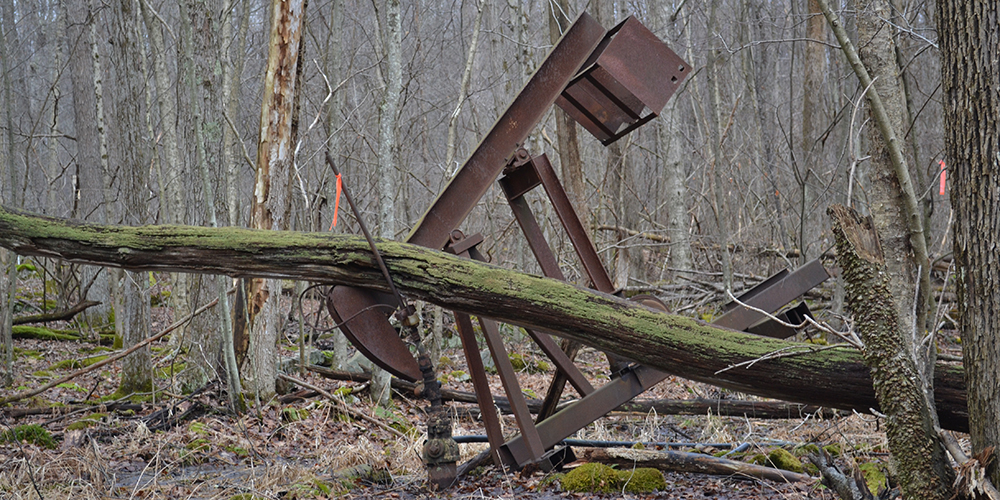DEP is starting to plug wells using funds from the Infrastructure Investment and Jobs Act (IIJA). Check out our dashboard to see projects that are underway.

When Edwin Drake became the first person to drill a commercial oil well in Titusville, Pennsylvania in 1859, he kicked off what would be known as the “black gold rush.” Thousands of oil wells sprung up along the Oil Creek banks and expanded rapidly throughout the region as oil quickly became one of the most valuable commodities. Unlike the California gold rush, which lasted only a few years, oil production in what is now known as Pennsylvania’s “Oil Patch” was booming until the mid-1870s when the “rush” to control oil production was over. As drilling operations slowed, these once profitable oil wells were abandoned and forgotten about – a cycle that has repeated itself multiple times throughout Pennsylvania’s history.

Pioneer Run oil field in 1859. Photo used with permission from the Pennsylvania Historical Collection and Museum Commission, Drake Well Museum Collection, Titusville, PA
Orphaned or Abandoned?
The
Oil and Gas Act defines an orphan well as “A well abandoned prior to April 18, 1985, that has not been affected or operated by the present owner or operator and from which the present owner, operator or lessee has received no economic benefit other than as a landowner or recipient of a royalty interest from the well.”
An abandoned well is defined as “a well: (i) that has not been used to produce, extract or inject any gas, petroleum or other liquid within the preceding 12 months; (ii) for which equipment necessary for production, extraction or injection has been removed; or (iii) considered dry and not equipped for production within 60 days after drilling, redrilling or deepening. The term does not include wells granted inactive status.”

How Oil and Gas Wells are Plugged
Old, decaying, abandoned wells not only act as a significant source of climate-warming methane emissions, but in certain cases, can leak oil and gas into water, soil and sometimes nearby homes, businesses, churches and schools, creating a potential explosion or exposure hazard. Due to problems such as these, the Oil and Gas Act of 1984 required oil and gas well operators to plug non-producing wells in a manner that is protective of other natural resources and public health and safety. It followed much earlier plugging practices of utilizing wood, sediment and other items such as cannon balls to plug the wells.

DEP's Well Plugging Program utilizes a specific method to plug these wells. First, a specialty rig moves over the well and cleans out the well to the total depth or an attainable bottom depth (as deep as possible). Cleaning out the well includes removing debris in the well and materials used in the well construction, such as casing and tubing. It is also common to find other things such as wooden plugs, rope, old cement plugs, and yes, the previously mentioned cannonballs from prior plugging attempts. All the debris and material need to be removed for successful plugging. Once the well is cleaned out, the plugging process begins by placing cement in the well through the gas and oil-producing zones. These cement plugs, at times, are spaced within the well using bentonite gel spacers (mixtures of clay and water). The end goal of the plugs is to prevent upward movement of fluids (gas, oil, or brine). Once the well is plugged, the area around the well is restored to its previous condition or as close to that as possible. On average, the DEP estimates the cost of plugging one well to be around $33,000. However, complications such as excess debris can cause the cost to plug these wells to increase up to $800,000.

Well Plugging Priority
DEP’s Well Plugging Program was established to plug oil and gas wells where there is no identifiable responsible party. Since the Well Plugging Program began, DEP has documented over 25,000 abandoned wells and plugged more than 3,000 wells. Plugging priority is determined through site investigations that assign a numeric score based on the abandoned well’s risk. Risks associated with abandoned wells that are considered in the prioritization process include oil leakage into water resources, health and safety issues like methane migrating into homes and private water wells, and fugitive methane emissions being released into the atmosphere. Higher risk wells are plugged before lower risk wells.

How You Can Help
If you discover an abandoned well, DEP is available to ensure that it has been properly identified and that any potential environmental, health and safety issues are addressed, as resources allow. You can
contact DEP by calling one of the Oil and Gas District offices:
- Meadville District Office: 814.332.6860
- Williamsport District Office: 570.327.3636
- Pittsburgh District Office: 412.442.4000